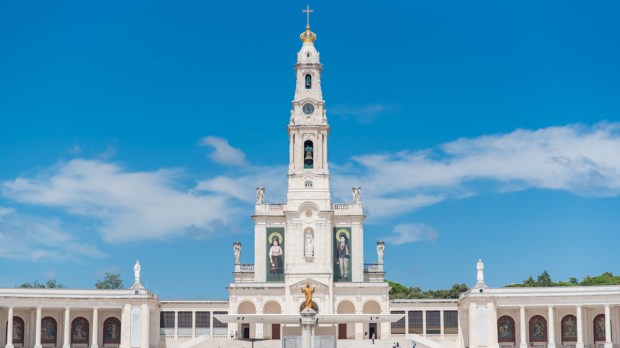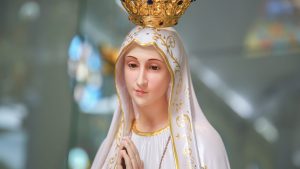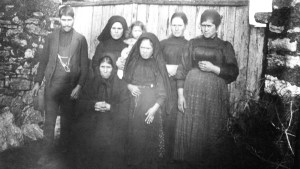During his trip to Portugal from August 2 to 6 for World Youth Day in Lisbon, Pope Francis will visit the Sanctuary of Our Lady of of Fatima, some 100 kilometers from the capital, on August 5. Aura Miguel, a Portuguese journalist who has been covering the Church for more than 35 years for Radio Renascença — owned by the Portuguese Bishops’ Conference — and author of a book on Fatima, explains to I.MEDIA the role this shrine plays for Portuguese Catholics and its close relationship with the popes and their mission.
According to tradition, the Virgin Mary appeared six times between May 13 and October 13, 1917, to Francisco and Jacinta Marto and their cousin Lucia dos Santos, three shepherd children, on the site where the shrine is built. The children reported that the Virgin Mary had entrusted them with three secrets, some of which were revealed to the world in 1941 and others in 2000. The Mother of God asked them to pray for world peace and encouraged devotion to her Immaculate Heart.
What does the sanctuary of Fatima mean to the Portuguese population?
Aura Miguel: It is the heart of the mother that is there; this maternal presence is unavoidable for Portuguese Catholics. This is a very interesting phenomenon because there are many people who are not all that practicing, but do not miss the Fatima celebrations. There is a kind of silent umbilical cord that binds the Portuguese to Fatima. It is not only in the moments of great celebrations, such as on the 13th of the month between May and October, which are the 6 anniversaries of the apparitions. There are also many people who just go there alone at night, for example. It is a place of great peace also outside of the great celebrations.
Fatima is absolutely inseparable from the identity of Portuguese Catholics. When Pope Benedict XVI landed in Lisbon, he said that in Portugal in 1917 a window of hope was opened on Fatima and that is a great reading. That window springs from that message, so strong and simple, offering a great possibility of peace to the world, because it was entrusted to three simple and illiterate children and therefore it is accessible to everyone. That is a beautiful thing to witness.
Fatima is a silent force that I think reveals the faith that still exists in the hearts of the Portuguese and that does not make headlines or the newspapers’ front pages.
Have you witnessed it?
Aura Miguel: I was there as a journalist for the celebrations on May 13 this year. The Masses are very long and are always held under the sun without even a shadow. At the conclusion, when it was time for the blessing of all the faithful, who had filled the sanctuary after the years of the pandemic, there was a total silence. I could hear the birds; it was as if no one was there.
Fatima is a silent force that I think reveals the faith that still exists in the hearts of the Portuguese and that does not make headlines or the newspapers’ front pages. However, deep down I think it is this potential that helps the Pope to be Pope, and also helps each of us to face the difficulties that arise in everyday life. It helps us to have this hope that God never abandons his Church, regardless of the problems she suffers and goes through.
What does a Pope’s visit to the Sanctuary of Fatima mean?
Aura Miguel: I consider Fatima to be inseparable from the Pope, whoever he may be. In the apparitions of July 13, 1917, Our Lady revealed the secret to the little shepherds and prophesied that the Holy Father would have much to suffer. The message of Fatima has always been linked to the Holy Father, we have seen it from the first hour, especially since Pius XII. He always felt very connected because he was ordained bishop on May 13, 1917, exactly on the date of the first apparition. He exchanged correspondence with Sister Lucia and was known as “the Pope of Fatima.” Pius XII did not visit Fatima because at that time popes did not travel. Paul VI came to Fatima on the 50th anniversary of the apparitions in 1967, at the time of the Council’s upheavals, for a quick one-day visit.
Then there was the assassination attempt on John Paul II, on May 13, 1981. He surpassed Pius XII as pope of Fatima. John Paul II said his pontificate was only 3 years, from 1978 to 1981, until the day of the attack and the rest was a miracle of Our Lady of Fatima. Then he traveled to Fatima three times, the year after the attack in 1982, 10 years after the attack in 1991 and in 2000, in the middle of the Jubilee, to beatify the little shepherds. Then Pope Benedict XVI came in 2010. Pope Francis went to Fatima for the centenary of the apparitions in 2017 [and the canonization of the little shepherds] and he is a very Marian pontiff. During World Youth Day in Rio de Janeiro, he also went to the Shrine of Our Lady of Aparecida.
How is the sanctuary of Fatima still relevant today?
Aura Miguel: It was key what Benedict XVI explained when he came in 2010. On the plane on the way to Lisbon he recalled that a large part of the third secret had to do with the attack on John Paul II but there was also another piece. This would always be for everyone and had to do with the suffering of the Church and that of the Pope, which is inherent in his vocation as Peter. This is where Pope Benedict XVI’s phrase became famous: “the attacks on the Pope and the Church come not only from without, but the sufferings of the Church come precisely from within the Church.”
When he arrived in Fatima he also reminded us that those who think that Fatima is no longer relevant are mistaken, because the question of conversion is permanent and demanding, and increasingly urgent. He even compared the adherence of the little shepherds, when they said yes to Our Lady’s requests, with what is needed to save the world. As he had already recalled in the theological consideration that accompanied the publication of the secret in 2000, when he was still Prefect of the Dicastery for the Doctrine of the Faith, he explained that whoever adheres to Fatima, whoever says yes to the requests that Our Lady brought, generates a force for good. Therefore, Fatima is a force that generates peace and Benedict XVI said that this also helped him to be Pope.



